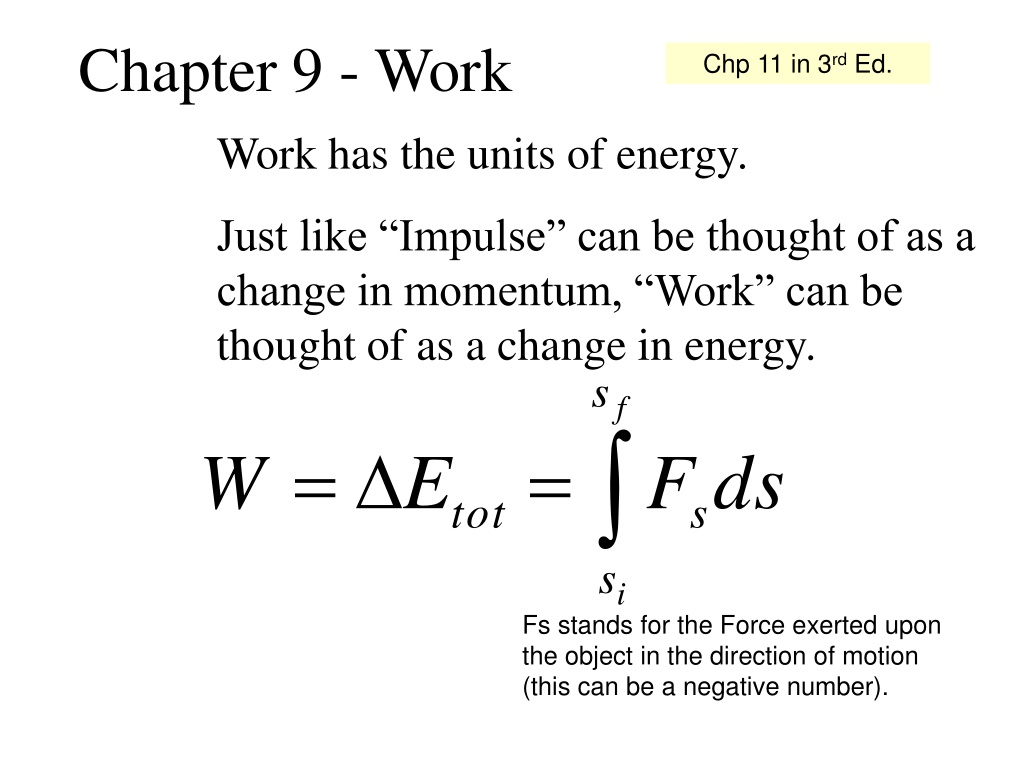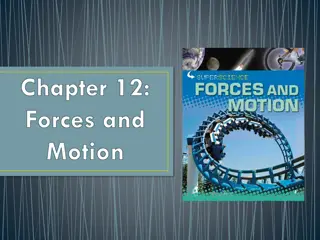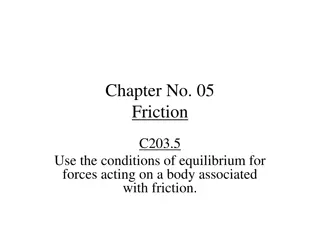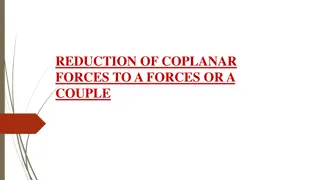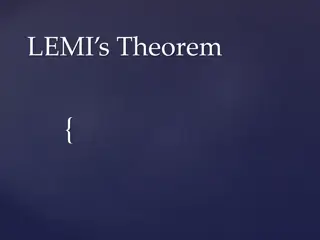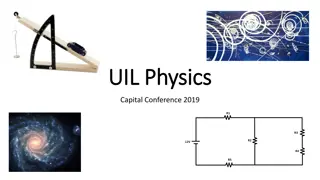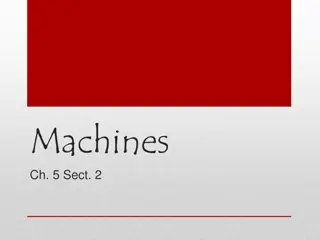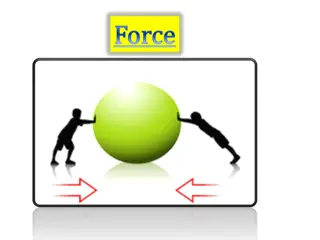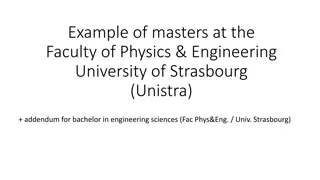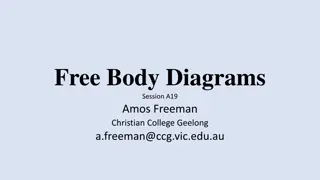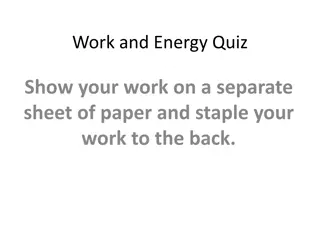Work, Energy, and Forces in Physics
Relationship between work, energy, and forces in physics through concepts like impulse, momentum, potential energy, and kinetic energy. Understand how forces impact motion and how work relates to changes in energy. Dive into scenarios involving crates, blocks, springs, and particles to grasp the practical applications of these fundamental principles in physics.
Download Presentation

Please find below an Image/Link to download the presentation.
The content on the website is provided AS IS for your information and personal use only. It may not be sold, licensed, or shared on other websites without obtaining consent from the author.If you encounter any issues during the download, it is possible that the publisher has removed the file from their server.
You are allowed to download the files provided on this website for personal or commercial use, subject to the condition that they are used lawfully. All files are the property of their respective owners.
The content on the website is provided AS IS for your information and personal use only. It may not be sold, licensed, or shared on other websites without obtaining consent from the author.
E N D
Presentation Transcript
Chapter 9 - Work Work has the units of energy. Chp 11 in 3rd Ed. Just like Impulse can be thought of as a change in momentum, Work can be thought of as a change in energy. s Fs stands for the Force exerted upon the object in the direction of motion (this can be a negative number). s f = = W E F ds tot s i
s f s = = W E F ds tot s i This s is important. This really turns into: s f s = = W E F s d tot i
Chapter 11 http://www.falstad.com/dotproduct/
s f s = = W E F s d tot T i You pull this 5.0kg crate along a carpeted floor ( k = .80) with a rope of T=75N at an angle of 30.0 degrees above the floor. What is the speed of the crate after 1.0 meters of pulling?
A block slides down a rough board. What sign convention is correct if the problem is set up as shown? 1. +++ 2. ++- 3. +-+ 4. -++ 5. --+ 6. -+- 7. +-- 8. --- Wof_friction_on_block Wgravity_on_block = KE
A block slides down a rough board. What sign convention is correct if the problem is set up as shown? 1. +++ 2. ++- 3. +-+ 4. -++ 5. --+ 6. -+- 7. +-- 8. --- mgh Ethermal KE =
A particle moving along the x-axis experiences the force shown in the graph. If the particle has 2.0 J of kinetic energy as it passes x = 0 m, what is its kinetic energy when it reaches x = 4 m? 1. -2.0J 2. 0.0J 3. 2.0J 4. 4.0J 5. 6.0J
Using Work to define the Potential Energy of a Spring s f s = = W E F ds tot s i Let s start with the spring compressed and see what work the spring does on the mass by the time the spring reaches it s equilibrium position. s f i s = = ( ) W E ks ds tot
We can do the same thing for gravity on the surface of Earth: s s f f s s s s = = = = = = ( ) ( ) W E F ds mgds mgs mg s s mg s f tot s f i i i i The cool thing about this is it doesn t matter how you get from point A to point B . Forces that are path independent are called Conservative Forces
Power Defined Power = Energy / time 1 Watt = 1Joule/1sec Using the following tools, find your maximum power output: ruler stopwatch stairs
A child slides down a playground slide at constant speed. The energy transformation is 5. There is no transformation because energy is conserved.
A particle moving along the x-axis experiences the force shown in the graph. If the particle has 2.0 J of kinetic energy as it passes x = 0 m, what is its kinetic energy when it reaches x = 4 m? 1. 2.0 J 2. 0.0 J 3. 2.0 J 4. 4.0 J 5. 6.0 J
A crane lowers a steel girder into place at a construction site. The girder moves with constant speed. Consider the work Wg done by gravity and the work WT done by the tension in the cable. Which of the following is correct? 1. Wg is positive and WT is positive. 2. Wg is negative and WT is negative. 3. Wg is positive and WT is negative. 4. Wg and WT are both zero. 5. Wg is negative and WT is positive.
Which force does the most work? 1. The 6 N force. 2. The 8 N force. 3. The 10 N force. 4. They all do the same amount of work.
A particle moves along the x-axis with the potential energy shown. The force on the particle when it is at x = 4 m is 1. 4 N. 2. 2 N. 3. 1 N. 4. 1 N. 5. 2 N.
A child at the playground slides down a pole at constant speed. This is a situation in which 1. U Eth. Emech is conserved. 2. U K. Emech is not conserved but Esys is. 3. K Eth. Emech is not conserved but Esys is. 4. U Eth. Emech is not conserved but Esys is. 5. U Wext. Neither Emech nor Esys are conserved.
Four students run up the stairs in the time shown. Rank in order, from largest to smallest, their power outputs Pa to Pd. 1. Pb > Pa = Pc > Pd 2. Pd > Pa = Pb > Pc 3. Pd > Pb > Pa > Pc 4. Pb > Pa > Pc > Pd 5. Pc > Pb = Pa > Pd
What velocity do you need to achieve to burn the energy in 1 eggo if traveling only on horizontal ground? 1 eggo = 1.6 million Joules How many seconds does it take to achieve this speed if you could burn an eggo at a power of 300Watts?
Example 2: A 1000 kg car is rolling slowly across a level surface at 1.0 m/s, heading toward a group of small innocent children. The doors are locked, so you can t get inside to use the brakes. Instead, Supergril rushes in and pushes on the hood at an angle 30 below horizontal. How hard must she push to stop the car in a distance of 2.0 m?
We could do this problem via the old way of using forces and accelerations. But let s try doing it using Energy and Work. The car starts out with a K= mv2 of energy. In order to save the jay-walking family, we need to get rid of all of that Kinetic Energy.
Chapter 11 Reading Quiz
The statement K = W is called the 1. law of conservation of energy. 2. work-kinetic energy theorem. 3. kinetic energy equation. 4. weight-kinetic energy theorem.
The statement K = W is called the 1. law of conservation of energy. 2. work-kinetic energy theorem. 3. kinetic energy equation. 4. weight-kinetic energy theorem.
The transfer of energy to a system by the application of a force is called 1. Dot product. 2. Power. 3. Work. 4. Watt. 5. Energy transformations.
The transfer of energy to a system by the application of a force is called 1. Dot product. 2. Power. 3. Work. 4. Watt. 5. Energy transformations.
A child slides down a playground slide at constant speed. The energy transformation is 5. There is no transformation because energy is conserved.
A child slides down a playground slide at constant speed. The energy transformation is 5. There is no transformation because energy is conserved.
A particle moving along the x-axis experiences the force shown in the graph. If the particle has 2.0 J of kinetic energy as it passes x = 0 m, what is its kinetic energy when it reaches x = 4 m? 1. 2.0 J 2. 0.0 J 3. 2.0 J 4. 4.0 J 5. 6.0 J
A particle moving along the x-axis experiences the force shown in the graph. If the particle has 2.0 J of kinetic energy as it passes x = 0 m, what is its kinetic energy when it reaches x = 4 m? 1. 2.0 J 2. 0.0 J 3. 2.0 J 4. 4.0 J 5. 6.0 J
A crane lowers a steel girder into place at a construction site. The girder moves with constant speed. Consider the work Wg done by gravity and the work WT done by the tension in the cable. Which of the following is correct? 1. Wg is positive and WT is positive. 2. Wg is negative and WT is negative. 3. Wg is positive and WT is negative. 4. Wg and WT are both zero. 5. Wg is negative and WT is positive.
A crane lowers a steel girder into place at a construction site. The girder moves with constant speed. Consider the work Wg done by gravity and the work WT done by the tension in the cable. Which of the following is correct? 1. Wg is positive and WT is positive. 2. Wg is negative and WT is negative. 3. Wg is positive and WT is negative. 4. Wg and WT are both zero. 5. Wg is negative and WT is positive.
Which force does the most work? 1. The 6 N force. 2. The 8 N force. 3. The 10 N force. 4. They all do the same amount of work.
Which force does the most work? 1. The 6 N force. 2. The 8 N force. 3. The 10 N force. 4. They all do the same amount of work.
A particle moves along the x-axis with the potential energy shown. The force on the particle when it is at x = 4 m is 1. 4 N. 2. 2 N. 3. 1 N. 4. 1 N. 5. 2 N.
A particle moves along the x-axis with the potential energy shown. The force on the particle when it is at x = 4 m is 1. 4 N. 2. 2 N. 3. 1 N. 4. 1 N. 5. 2 N.
A child at the playground slides down a pole at constant speed. This is a situation in which 1. U Eth. Emech is conserved. 2. U K. Emech is not conserved but Esys is. 3. K Eth. Emech is not conserved but Esys is. 4. U Eth. Emech is not conserved but Esys is. 5. U Wext. Neither Emech nor Esys are conserved.
A child at the playground slides down a pole at constant speed. This is a situation in which 1. U Eth. Emech is conserved. 2. U K. Emech is not conserved but Esys is. 3. K Eth. Emech is not conserved but Esys is. 4. U Eth. Emech is not conserved but Esys is. 5. U Wext. Neither Emech nor Esys are conserved.
Four students run up the stairs in the time shown. Rank in order, from largest to smallest, their power outputs Pa to Pd. 1. Pb > Pa = Pc > Pd 2. Pd > Pa = Pb > Pc 3. Pd > Pb > Pa > Pc 4. Pb > Pa > Pc > Pd 5. Pc > Pb = Pa > Pd
Four students run up the stairs in the time shown. Rank in order, from largest to smallest, their power outputs Pa to Pd. 1. Pb > Pa = Pc > Pd 2. Pd > Pa = Pb > Pc 3. Pd > Pb > Pa > Pc 4. Pb > Pa > Pc > Pd 5. Pc > Pb = Pa > Pd
Example 3: A 1.0 kg block moves along the x-axis. It passes x = 0 m with velocity vx = 2.0 m/s. It is then subjected to the force shown in the graph. Which of the following is true: The block gets to x = 5 m with a speed greater than 2.0 m/s, the block gets to x = 5 m with a speed of exactly 2.0 m/s, the block gets to x = 5 m with a speed of less than 2.0 m/s, or the block never gets to x = 5 m?
A balloon of mass m is filled with flour. Attached to a string it is released from height h and swings to hit a box of mass M (similar to lab 6). The box then slides a distance d before coming to rest. What is the coefficient of kinetic friction between the box and the table upon which it slides?
